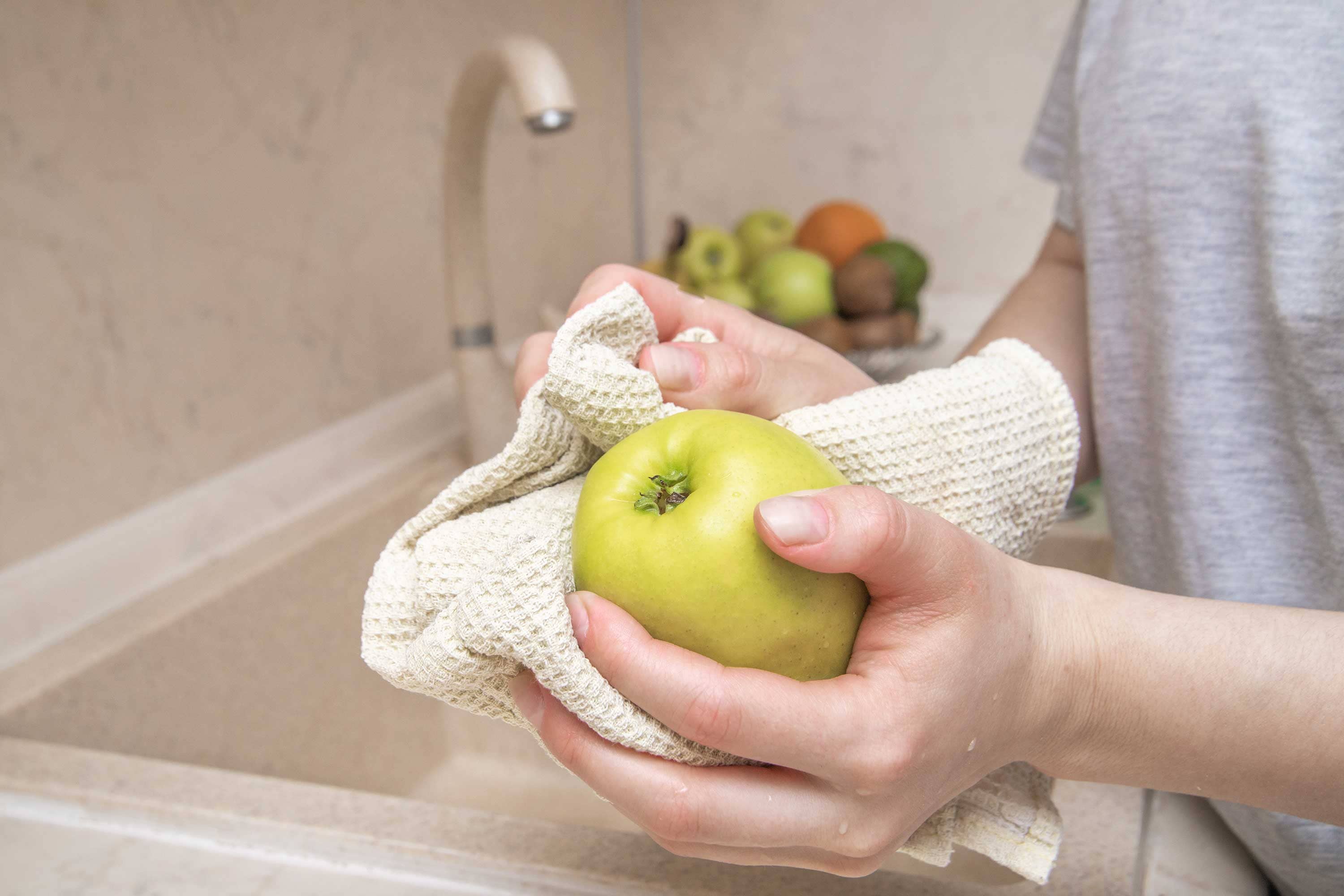Cleaning vs. Sanitizing – Wet vs. Dry
Before diving into dry sanitation practices, it’s important to understand the big difference between cleaning and sanitizing, an area that people often get confused. Cleaning is the process of physically removing any unwanted soil from an area or surface. Sanitizing is the subsequent process of treating cleaned surfaces to reduce and prevent cross-contamination of pathogenic microorganisms.
Breaking this down further, wet cleaning refers to the method of removing the unwanted soil with water and other products such as mild detergent. It is the most common cleaning method used in the fresh produce industry. Dry cleaning also removes the soil and organic matter, but with tools such as dry brushes or towels.
Wet sanitizing removes the presence of pathogenic microbes traditionally with sanitizing solutions that are water based. Instead, dry sanitizing practices can include non water-based chemical such as alcohol, or other types of dry sanitizing equipment.
Where is Dry Sanitation used?
The purpose of dry sanitation is to utilize cleaning and sanitizing methods that minimize water use as much as possible. Because of nature of the ingredients used and their sensitivity to water, this process is more commonly used within the baking and confectionary industry. Dry sanitation is often employed in areas or situations where the presence of water may pose a risk of equipment damage, electrical hazards, or environmental microbial growth (e.g. Listeria and Salmonella). It is commonly used in food processing facilities for specific equipment or areas.
Within the produce industry, dry sanitation practices are mainly focused on equipment in packinghouses that do not use water in the packing process. It is worth noting that some produce operations may refer to a “dry sanitation” process where water is still used, but in a controlled manner (i.e. manual cleaning with buckets of water and detergent vs. a ‘washdown’ with spraying water). This has led to confusion and differing perspectives on what dry sanitation really is. Additional misconceptions and questions surrounding dry sanitation include efficacy compared to traditional water-based cleaning, odor/hygiene concerns, limited applicability, and regulatory compliance.
Regardless of how the term is being used, what matters most is that therisk of introducing water in a dry (or mostly dry) operation is being properly managed and monitored.
What are some examples of tools and technologies* used for dry sanitation?
- Cleaning Tools: Brushes, vacuum cleaners, towels, buckets, non-abrasive scrub pads,
- Surface wipes ~35% Water with 65% isopropyl alcohol/quat mixture (for equipment)
- Superheated dry steam
- Chlorine dioxide gas
- UV-C Radiation
- Thermal Plasma
*Some technologies being explored for use in dry sanitation are in various stages of development and may yet not be practical for scaled-up used in a packing or handling environment. For operation considering the use of new technologies or new vendors, IFPA has developed an Assessment Tool for Food Safety Product/Service Vendors to facilitate reviews of the products, services, and technologies offered to the produce industry.
When and why might produce industry members implement dry sanitation practices?
The biggest food safety benefit of dry sanitation practices is the management of water in the packing environment, helping prevent the outgrowth of environmental contaminants that may have taken up residence in cracks, crevices, and other hard-to-clean areas. However, dry cleaning and sanitizing are not always appropriate for all sectors of the produce industry.
Some instances when dry sanitation practices could be considered include water scarcity, water-sensitive produce, equipment/ area constraints, and/or implementing dry practices only for specific packing/ processing stages. Water scarcity and water-sensitive produce are very important examples because dry sanitation practices could help conserve water resources and prevent spoilage, degradation, and/or loss of quality of sensitive produce.
Some examples of commodities and packing operations that utilize dry sanitation practices at least some, or all of the time, include avocados, berries, stone fruit, onions, and repack operations.
Regardless of what sanitation method an operation chooses (wet or dry), the knowledge of zoning is very important when categorizing what takes priority in cleaning and sanitizing, and how environmental monitoring should be designed for verification purposes. Sanitary design of equipment and facilities is also very important because it generates a structure of timely cleaning, minimizes the potential for microbial contamination, and inspection of equipment.
What else is needed?
Unfortunately, while some materials exist for the baking and confectionary industries, very few research or resources exist on the topic of dry sanitation in produce operations. Those that exist can be extremely hard to find. Additional resources would be helpful in furthering industry’s knowledge on dry sanitation that are tailored to different produce commodities, as well as sanitation technologies that are used in dry sanitation practices. As these resources are developed it will be important for companies, wholesalers, and distributors to communicate effectively what their definition of dry cleaning/sanitizing is to eliminate any confusion and ensure the applicability of such resources.
Industry Resources:
- IFPA Virtual Town Hall – Dry Sanitation in the Fresh Produce Industry
- CPS Funded Research - Cross-contamination risks in dry environments
- CPS Funded Research - Survival of Listeria monocytogenes and Salmonella on surfaces found in the dry packinghouse environment and effectiveness of dry-cleaning processes on pathogen reduction
- Rochester Midland Corporation - Where is Dry Sanitation appropriate or necessary?
- Commercial Food Sanitation - Wet vs Dry Cleaning (Part two)
- Quality Assurance Magazine - Reducing Moisture to Increase Food Safety
- Ecolab Webinar - Dry/Low Moisture Cleaning
This resource was developed by Dachauna Johnson, IFPA Food Safety Intern.
For additional questions, please contact the IFPA Food Safety team.
